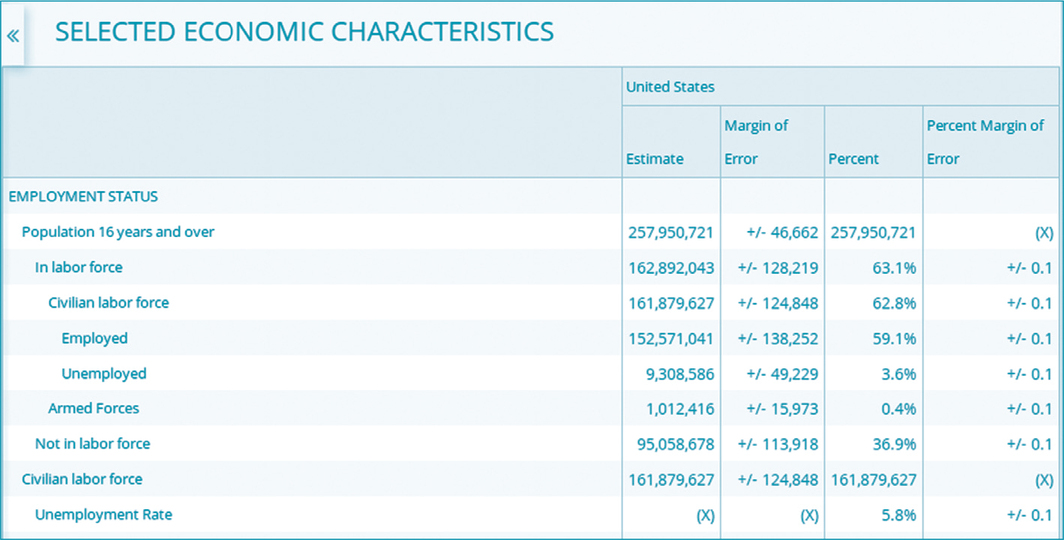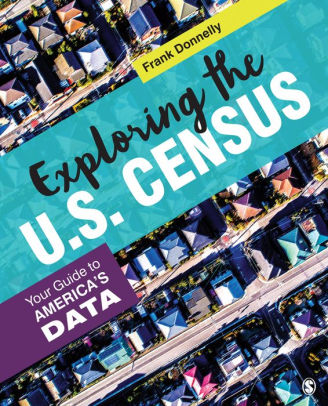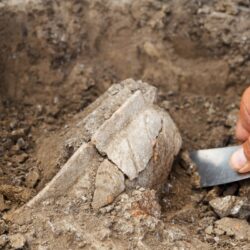Research and the Census: Exploring the Labor Force
Editor’s Note: This is an excerpt from Chapter 4 of Frank Donnelly’s Exploring The U.S. Census. A follow-up except will look at labor force statistics in more detail.
The concept of the labor force describes a person’s employment status, and like all U.S. Census Bureau definitions, the terminology is quite specific. The labor force consists of all people 16 years of age or older who are working (employed), are not working but are actively seeking work (unemployed), or are members of the U.S. Armed Forces (on active duty in the Army, Air Force, Navy, Marines, or Coast Guard). This is important to understand: Members of the military are part of the labor force but are neither employed nor unemployed, they exist in their own separate category. Economists who do not want to factor in the military look at the civilian labor force, which consists of just the employed and the unemployed. The Census Bureau indents descriptions in its tables to indicate whether a category is a subgroup of another category. Notice in Figure 1 how both the civilian labor force and armed forces are indented under “In Labor Force” indicating that both are part of the labor force, while employed and unemployed are indented as subcategories under civilian labor force.

Within the civilian labor force, people are counted as employed if they were either at work during the reference frame for the survey or held a job but were not at work during the reference period due to a temporary absence (illness, vacation, union action, or personal reasons). A person is counted as employed if they did any work during the reference period as a paid employee, worked in their own business or profession (including farming), or worked 15 or more unpaid hours a week as part of a family business or farm. Persons who engage in unpaid volunteer work and personal housework or home repairs are not counted as being employed.
Within the civilian labor force, people are counted as unemployed if they want a job, are actively seeking work, and are available to start working, but they currently do not have a job. Examples of job-seeking activities that would verify a person’s status as unemployed include registering at an unemployment Office, going to job interviews, and submitting job applications and résumés. The unemployed also include people who were laid off from a job temporarily and are waiting to be called back and people who could work but have a temporary illness that precludes them from holding a job. The unemployment rate represents the number of unemployed people divided by the total civilian labor force (the sum of the civilian employed and unemployed). Military personnel are never factored into the unemployment rate; they are part of the labor force but not the civilian labor force.
Outside of the labor force (civilians and military) are people who are not in the labor force. People not in the labor force include full-time students, stay-at-home parents, retirees, unpaid volunteers, institutionalized people (in prison, nursing homes, pyschiatric hospitals), people doing less than 15 hours a week of unpaid family work (for a business or farm), seasonal workers who are interviewed during an off-season when they are not working, and anyone else who is simply not employed and not looking for work. There is a big distinction between people who have no job and are not looking for work and the unemployed population, who are part of the labor force because they are actively seeking work.
The labor force participation rate represents the percentage of the population 16 years and older who are in the labor force. This consists of everyone in the labor force (employed, unemployed, and military) divided by the total population 16 years and older. The labor force participation rate measures how active society is in the working world. A low participation rate indicates that a smaller segment of the population must work to support a larger segment that isn’t working.
When we read stories in our news feed about how the unemployment rate is going down, we have to interpret these numbers with caution. For example, the unemployment rate can go down either because people have found jobs or because people have left the labor force. The first case is good news, while the second case may or may not be. People leave the labor force because they are able to retire, or they leave due to injury or simply because they have given up looking for a job because it is too hard to find. Conversely, the unemployment rate can go up either because people have lost their jobs, or because more people have suddenly joined the labor force to look for work. The first case is bad news, while the second case could be good or bad. The economy may be strong enough that people are more confident that they can find work, or then again maybe people are forced to go to work because they can’t afford not to.
The decennial census does not ask questions on labor force status. The American Community Survey (ACS), Current Population Survey (CPS), and a number of surveys from the Bureau of Labor Statistics (BLS) employ these labor force concepts and measure additional characteristics on occupation, industry, and whether work is full-time or part-time. The ACS is appropriate for getting a broad picture of the labor force for geographic areas large and small. The CPS and BLS are better for more up-to-date statistics that cover large geographic areas.
The population-centered census datasets focus on the resident labor force, which are the members of the labor force who live in a particular place. This is quite different from measuring the labor force where they actually work. The ACS does ask some questions on residency by place of work, and the business-focused datasets (the Business Patterns and the Economic Census) count the number of businesses by location, including the number of employees and wages. Labor force and business data are usually divided into specific sectors and industries that describe the primary type of work that is being performed.

Frank Donnelly’s new book, Exploring the US Census: Your Guide to America’s Data, aims to give social science students and researchers alike the tools to understand, extract, process, and analyze data from the decennial census, the American Community Survey, and other data collected by the U.S. Census Bureau.































































































This makes no sense that the military has their own capacity of employment and being stated as neither employed or unemployed. While serving we are considered employed by whatever branch of service we are serving in. We sign a contract for our employment, are paid a salary, receive health benefits, retirement, are considered employed by creditors, are eligible for unemployment benefits, file and pay employment income taxes, yet we do not fall under US labor laws. We are considered “in a job” it’s just called a military occupational skill or MOS. We receive OJT or “on the JOB training”. I… Read more »